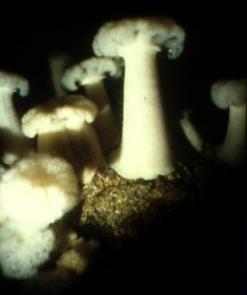Metridium
- Actinia senile Linneus 1767
- Metridium parvulum Mc Murrich [sic] 1904
- Metridium canum Stuckey 1914
Characteristics
Metridiidae with well developed base. Column devided [sic] into scapus and capitulum, the former ending above in a decided collar which is especially distinct in older individuals. The capitulum lies above the collar and is extensive. Cinclides scattered below the collar. Sphincter in the uppermost part of the scapus, mesogloeal. Tentacles short, numerous, their longitudinal muscles ectodermal. Radial muscles of oral disc ectodermal to meso-ectodermal. Oral disc circular in the young, but deeply and conspicuously lobed in the adult. Siphonoglyphs variable in number, usually one or two. Perfect mesenteries very variable in number, typically 6 pairs but often more. The six primary pairs sterile in typical individuals. Retractors diffuse, sometimes short and broad in sections. Acontia well developed, their nematocysts microbasic b-mastigophors and microbasic amastigophors, the latter sometimes absent in older individuals. Cnidom: spirocysts, basitrichs, microbasic b- and p-mastigophors, microbasic amastigophors.References
Carlgren, O. 1949. A Survey of the Ptychodactiaria, Corallimorpharia and Actiniaria. Kungl. Svenska Vetenskapsakadamiens Handlingar, series 4, volume 1, number 1.
Title Illustrations

Metridium giganteum.
This species was described after the publication of Carlgren's catalog and was, therefore, not included in his species list.
Photo copyright © 2000, Ron Ates.
Picture taken about 500 m in front of the Bodega Marine Lab, University of California.
About This Page
The information provided on this page is based on Oscar Carlgren's 1949 catalog.Copyright © 1949 Swedish Academy of Sciences.
Please note that Carlgren's text contains a number of errors, and much of the information is now out of date. An update of the catalog is currently under preparation in Daphne Fautin's laboratory, and the results of this work will be incorporated in future versions of this page.
Keyboarding of Carlgren's catalog was done as part of a project to create an electronic database of the sea anemones of the world, funded by NSF Grant DEB9521819, awarded to Daphne G. Fautin. This grant is in the program Partnerships to Enhance Expertise in Taxonomy (PEET). Susanne Hauswaldt, Katherine Pearson, and April Wakefield-Pagels contributed to the keyboarding effort.
Correspondence regarding this page should be directed to Daphne G. Fautin at
Page copyright © 2000
All Rights Reserved.
Citing this page:
Tree of Life Web Project. 2000. Metridium. Version 01 January 2000 (temporary). http://tolweb.org/Metridium/18228/2000.01.01 in The Tree of Life Web Project, http://tolweb.org/








 Go to quick links
Go to quick search
Go to navigation for this section of the ToL site
Go to detailed links for the ToL site
Go to quick links
Go to quick search
Go to navigation for this section of the ToL site
Go to detailed links for the ToL site